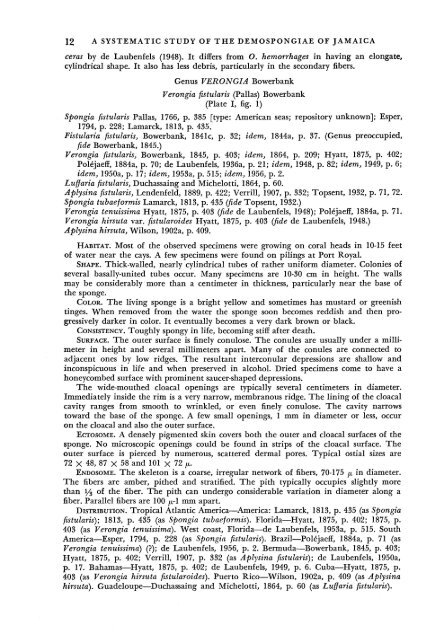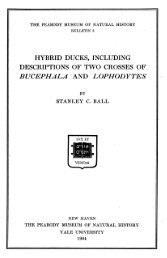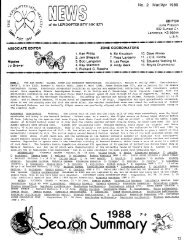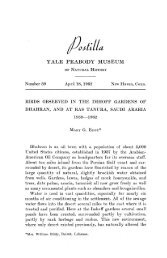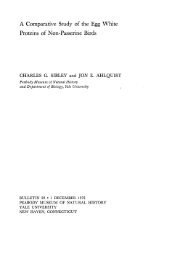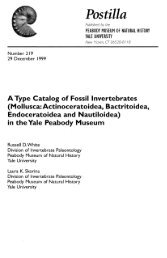Bulletin 20 - Peabody Museum of Natural History - Yale University
Bulletin 20 - Peabody Museum of Natural History - Yale University
Bulletin 20 - Peabody Museum of Natural History - Yale University
You also want an ePaper? Increase the reach of your titles
YUMPU automatically turns print PDFs into web optimized ePapers that Google loves.
12 A SYSTEMATIC STUDY OF THE DEMOSPONGIAE OF JAMAICA<br />
ceras by de Laubenfels (1948). It differs from O. hemorrhages in having an elongate,<br />
cylindrical shape. It also has less debris, particularly in the secondary fibers.<br />
Genus VERONGIA Bowerbank<br />
Verongia fistularis (Pallas) Bowerbank<br />
(Plate I, fig. 1)<br />
Spongia fistularis Pallas, 1766, p. 385 [type: American seas; repository unknown]; Esper,<br />
1794, p. 228; Lamarck, 1813, p. 435.<br />
Fistularia fistularis, Bowerbank, 1841c, p. 32; idem, 1844a, p. 37. (Genus preoccupied,<br />
fide Bowerbank, 1845.)<br />
Verongia fistularis, Bowerbank, 1845, p. 403; idem, 1864, p. <strong>20</strong>9; Hyatt, 1875, p. 402;<br />
Polejaeff, 1884a, p. 70; de Laubenfels, 1936a, p. 21; idem, 1948, p. 82; idem, 1949, p. 6;<br />
idem, 1950a, p. 17; idem, 1953a, p. 515; idem, 1956, p. 2.<br />
Luff aria fistularis, Duchassaing and Michelotti, 1864, p. 60.<br />
Aplysina fistularis, Lendenfeld, 1889, p. 422; Verrill, 1907, p. 332; Topsent, 1932, p. 71, 72.<br />
Spongia tubaeformis Lamarck, 1813, p. 435 (fide Topsent, 1932.)<br />
Verongia tenuissima Hyatt, 1875, p. 403 (fide de Laubenfels, 1948); Polejaeff, 1884a, p. 71.<br />
Verongia hirsuta var. fistularoides Hyatt, 1875, p. 403 (fide de Laubenfels, 1948.)<br />
Aplysina hirsuta, Wilson, 1902a, p. 409.<br />
HABITAT. Most <strong>of</strong> the observed specimens were growing on coral heads in 10-15 feet<br />
<strong>of</strong> water near the cays. A few specimens were found on pilings at Port Royal.<br />
SHAPE. Thick-walled, nearly cylindrical tubes <strong>of</strong> rather uniform diameter. Colonies <strong>of</strong><br />
several basally-united tubes occur. Many specimens are 10-30 cm in height. The walls<br />
may be considerably more than a centimeter in thickness, particularly near the base <strong>of</strong><br />
the sponge.<br />
COLOR. The living sponge is a bright yellow and sometimes has mustard or greenish<br />
tinges. When removed from the water the sponge soon becomes reddish and then progressively<br />
darker in color. It eventually becomes a very dark brown or black.<br />
CONSISTENCY. Toughly spongy in life, becoming stiff after death.<br />
SURFACE. The outer surface is finely conulose. The conules are usually under a millimeter<br />
in height and several millimeters apart. Many <strong>of</strong> the conules are connected to<br />
adjacent ones by low ridges. The resultant interconular depressions are shallow and<br />
inconspicuous in life and when preserved in alcohol. Dried specimens come to have a<br />
honeycombed surface with prominent saucer-shaped depressions.<br />
The wide-mouthed cloacal openings are typically several centimeters in diameter.<br />
Immediately inside the rim is a very narrow, membranous ridge. The lining <strong>of</strong> the cloacal<br />
cavity ranges from smooth to wrinkled, or even finely conulose. The cavity narrows<br />
toward the base <strong>of</strong> the sponge. A few small openings, 1 mm in diameter or less, occur<br />
on the cloacal and also the outer surface.<br />
ECTOSOME. A densely pigmented skin covers both the outer and cloacal surfaces <strong>of</strong> the<br />
sponge. No microscopic openings could be found in strips <strong>of</strong> the cloacal surface. The<br />
outer surface is pierced by numerous, scattered dermal pores. Typical ostial sizes are<br />
72 X 48, 87 X 58 and 101 x 72 /x.<br />
ENDOSOME. The skeleton is a coarse, irregular network <strong>of</strong> fibers, 70-175 JX in diameter.<br />
The fibers are amber, pithed and stratified. The pith typically occupies slightly more<br />
than I/3 <strong>of</strong> the fiber. The pith can undergo considerable variation in diameter along a<br />
fiber. Parallel fibers are 100 ^-1 mm apart.<br />
DISTRIBUTION. Tropical Atlantic America—America: Lamarck, 1813, p. 435 (as Spongia<br />
fistularis); 1813, p. 435 (as Spongia tubaeformis). Florida—Hyatt, 1875, p. 402; 1875, p.<br />
403 (as Verongia tenuissima). West coast, Florida—de Laubenfels, 1953a, p. 515. South<br />
America—Esper, 1794, p. 228 (as Spongia fistularis). Brazil—Polejaeff, 1884a, p. 71 (as<br />
Verongia tenuissima) (?); de Laubenfels, 1956, p. 2. Bermuda—Bowerbank, 1845, p. 403;<br />
Hyatt, 1875, p. 402; Verrill, 1907, p. 332 (as Aplysina fistularis); de Laubenfels, 1950a,<br />
p. 17. Bahamas—Hyatt, 1875, p. 402; de Laubenfels, 1949, p. 6. Cuba—Hyatt, 1875, p.<br />
403 (as Verongia hirsuta fistularoides). Puerto Rico—Wilson, 1902a, p. 409 (as Aplysina<br />
hirsuta). Guadeloupe—Duchassaing and Michelotti, 1864, p. 60 (as Luff aria fistularis).


